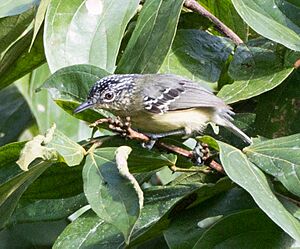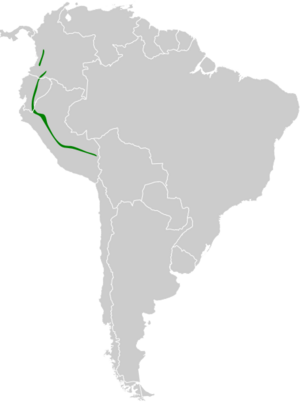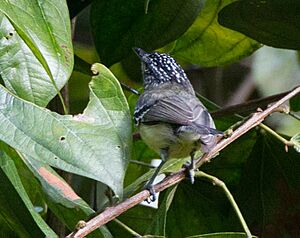Yellow-breasted antwren facts for kids
Quick facts for kids Yellow-breasted antwren |
|
|---|---|
 |
|
| Male near Zamora, Ecuador | |
| Conservation status | |
| Scientific classification | |
| Genus: |
Herpsilochmus
|
| Species: |
axillaris
|
 |
|
The yellow-breasted antwren (Herpsilochmus axillaris) is a small bird that lives in the forests of Colombia, Ecuador, and Peru. It belongs to a group of birds called "typical antbirds."
Contents
About This Bird
The yellow-breasted antwren has four different types, called subspecies. They are:
- H. a. senex
- H. a. aequatorialis
- H. a. puncticeps
- H. a. axillaris
Appearance
This little bird is about 11 to 12 centimeters (4.3 to 4.7 inches) long. It weighs around 10 to 13 grams (0.35 to 0.46 ounces).
- Male Birds: Adult males have a black cap on their head with white spots. They have an olive-gray back. Their wings are black with yellow-white edges. Their tail is mostly dark gray with white tips. Their throat and belly are pale yellowish-olive.
- Female Birds: Adult females have a reddish-brown cap. Their upper body is olive-buff, and their underparts are darker olive, but their belly is still yellow. Their wings and tail look similar to the male's.
Some subspecies have slight differences in color. For example, H. a. senex males are paler, and H. a. puncticeps males have grayer upper parts.
Where It Lives
The different types of yellow-breasted antwrens are found in specific areas:
- H. a. senex: Lives in the Andes mountains of Colombia.
- H. a. aequatorialis: Found on the eastern side of the Andes, from southwestern Colombia through eastern Ecuador and into northern Peru.
- H. a. puncticeps: Lives on the eastern side of the Andes in central Peru.
- H. a. axillaris: Found on the eastern side of the Andes in southeastern Peru.
These birds live inside and at the edges of wet evergreen forests. They usually prefer to stay high up in the trees, in the canopy. You can find them at different heights in the mountains:
- In Colombia: Between 800 and 2000 meters (2,600 to 6,600 feet).
- In Ecuador: Between 800 and 1700 meters (2,600 to 5,600 feet).
- In Peru: Between 750 and 1900 meters (2,500 to 6,200 feet).
Behavior
Movement
The yellow-breasted antwren is believed to stay in the same area all year long. It does not migrate.
Feeding Habits
This bird mainly eats insects and probably spiders. It usually hunts for food in pairs or small family groups. It rarely hunts alone. It often joins other bird species in mixed feeding flocks.
They typically look for food from the middle part of the forest up to the very top of the trees. They like to search among tangled vines. They move actively and carefully, catching prey by picking it off leaves, stems, and vines. Sometimes, they quickly fly out from a branch to grab an insect in the air.
Reproduction
Not much is known about how these birds reproduce. One female bird in Peru was found ready to lay an egg in March.
Sounds and Calls
The yellow-breasted antwren's song sounds like a dry, rattling trill. People have described it differently depending on the area:
- In Ecuador: "tree-ee-ee-ee-ee-ee-ew"
- In northern Peru: "tee-tee-TI-TI-titi'ti'tititititititer"
- In Cuzco, Peru: "chew tew-tew-TEE-TEE-ti-ti'ti'ti'tititi"
Their call is a short, downward-sloping whistle, like "tew" or "tchew."
Conservation Status
The IUCN (International Union for Conservation of Nature) has changed its assessment of the yellow-breasted antwren over time. Currently, it is listed as a species of "Least Concern." This means it is not in immediate danger of disappearing.
However, its population size is unknown, and it is thought to be decreasing. The biggest threat to this bird is that its forest home is being cut down more and more for wood and farms. This bird is very sensitive to human activity, so losing parts of its forest home can really hurt it.
The yellow-breasted antwren is considered uncommon in Colombia and rare to uncommon in Ecuador and Peru. Luckily, some parts of its range are in protected areas.



